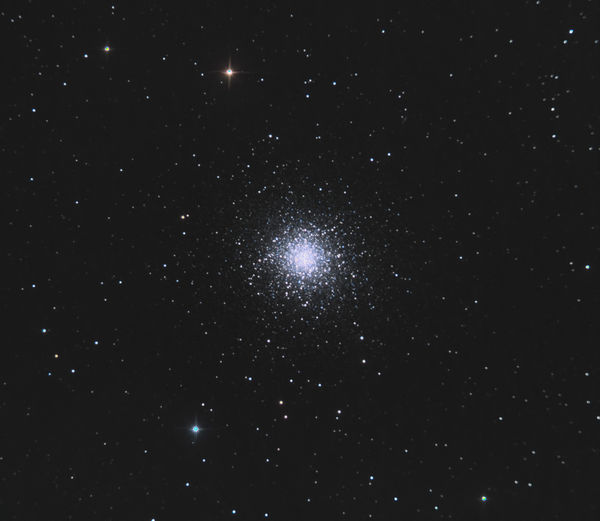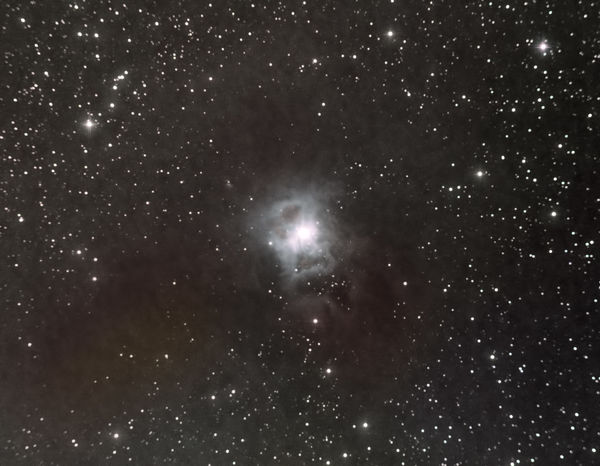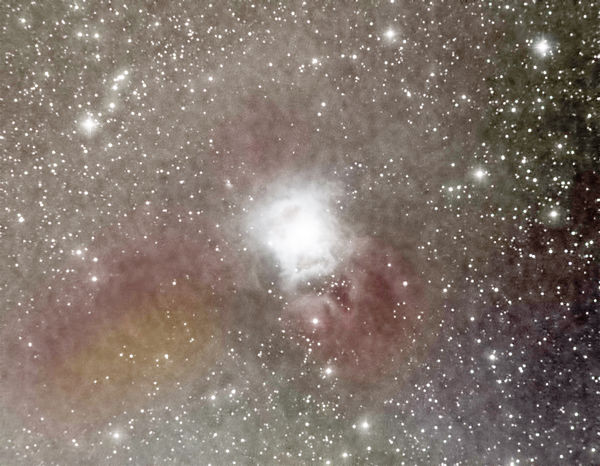I am about to renege on my....
May 21, 2017 06:27:26 #
At the beginning of the year I made a decision to spend what few nights I had shooting "up" using either my Atik 383L ccd or newly acquired ASI1600MM-C....and giving my Nikon cameras a rest. But try as I might, I cannot get images anywhere near the detail, color, and flat field with either of these two cameras. These two images were both shot with the ASI1600MM-C. M13 was LRGB and the IRIS nebula was L, Ha,OIII, and SII (Since there is a lot of nebulosity in this star field I was hoping....just hoping for a boost to my waning enthusiasm for these cameras. I have cropped out a lot of the pitiful donut, oblong, stars that are on the corners...but they are in abundance.
Besides the ASI camera, filter wheel, and filters, I used the Newt F/4 8 inch astrograph. I use a baader coma corrector but the field is far from flat.
Any ideas as to what could be causing the oblong stars in the corners (especially) with some of them looking like donuts (black holes in middle) and NO SONNY, I haven't discovered any black holes :)
Besides the ASI camera, filter wheel, and filters, I used the Newt F/4 8 inch astrograph. I use a baader coma corrector but the field is far from flat.
Any ideas as to what could be causing the oblong stars in the corners (especially) with some of them looking like donuts (black holes in middle) and NO SONNY, I haven't discovered any black holes :)
May 21, 2017 09:54:14 #
Well now, how would you know? Black Holes are black, in the blackness of black space. 
Is the other end of a black hole a white hole? Or like the Orion Nebula?
Something that kind of jumped out at me was the doubled spires appearing at the brightest stars.
And it made me wonder if they were from the Newt, or if you put them in as doubles intentionally.
I'd love to get pictures like that, myself. (Still waiting for Hell to freeze over...)

Is the other end of a black hole a white hole? Or like the Orion Nebula?
Something that kind of jumped out at me was the doubled spires appearing at the brightest stars.
And it made me wonder if they were from the Newt, or if you put them in as doubles intentionally.
I'd love to get pictures like that, myself. (Still waiting for Hell to freeze over...)
May 21, 2017 11:10:55 #
SonnyE wrote:
Well now, how would you know? Black Holes are blac... (show quote)
Those double spires are coming from the camera or filterwheel or both or perhaps a reflection from the coma corrector but I don't have those when using either the Atik or DLSRs. ....I also just spent a few minutes on Astrobin looking at others who use this camera and also use a Newt....and they don't have them.
I have lots to figure out. The learning curve has me by the b_ _ ls!
May 21, 2017 11:42:24 #
You're astrogrph is fast, I know for mine, I needed to get filters made for faster scopes. Of course, comes at a cost. Possibly the same is true for the coma corrector???? I don't use a coma corrector, but I too have the issue of the oblong and donut stars on the outside, so hopefully someone has some suggestions.
May 21, 2017 11:49:09 #
May 21, 2017 12:13:08 #
Europa wrote:
You're astrogrph is fast, I know for mine, I needed to get filters made for faster scopes. Of course, comes at a cost. Possibly the same is true for the coma corrector???? I don't use a coma corrector, but I too have the issue of the oblong and donut stars on the outside, so hopefully someone has some suggestions.
I do have the 31, 7nm filters for fast scopes. Now I didn't have those issues when using the DLSR cams.
May 21, 2017 16:01:02 #
nikonshooter wrote:
At the beginning of the year I made a decision to ... (show quote)
I think the over all beauty of the shots far exceeds the little blips in the corners.
Very well done Ed. Would shooting Flats help?
Craig
May 21, 2017 20:55:38 #
CraigFair wrote:
I think the over all beauty of the shots far exceeds the little blips in the corners.
Very well done Ed. Would shooting Flats help?
Craig
Very well done Ed. Would shooting Flats help?
Craig
You are kind - My struggle has an easy answer (go back to DSLR imaging)...I just can't seem to give up on the mono thingie just yet. I can go back to Nikon OSC's - take 150 subs a night - processing is a snap - round stars - detail - pretty good color....or I can stay the course with mono imaging using LRGB-NB... it takes multiple nights to get the data - and I am still trying to figure out how to process both the LRGB and NB using Hubble, Bi Color, other variations, both in PixInsight and in PS and I feel like I am making zip progress. If I ever figure it out - based on what others are doing with my camera and similar OTA's I know I will be pleased. But I am not there - and not too sure what to do. I did find another old man astro imager on Astrobin who lives 30 minutes from me. He is using the same camera and similar OTA's. We are going to try to plan a night to discuss and cuss our work.
May 21, 2017 21:35:08 #
nikonshooter wrote:
Those double spires are coming from the camera or filterwheel or both or perhaps a reflection from the coma corrector but I don't have those when using either the Atik or DLSRs. ....I also just spent a few minutes on Astrobin looking at others who use this camera and also use a Newt....and they don't have them.
I have lots to figure out. The learning curve has me by the b_ _ ls!
I have lots to figure out. The learning curve has me by the b_ _ ls!
As long as you don't have a another motor drive failure, you're way ahead of me.
I seem to be in a boulder pile.
Where to set up the mount?


May 21, 2017 22:02:28 #
SonnyE wrote:
As long as you don't have a another motor drive failure, you're way ahead of me.
I seem to be in a boulder pile.
Where to set up the mount?


I seem to be in a boulder pile.
Where to set up the mount?


:)
May 22, 2017 17:50:44 #
nikonshooter wrote:
At the beginning of the year I made a decision to ... (show quote)
A few comments:
1) The 1st image is out of focus which will give "hollow/donut" stars. I don't know how you focus but I find a Bahtinov mask gives me the best results. The focus on the 2nd image looks reasonable.
2) Both images could be improved with a field flattener. Not a reducer/flattener, simply a field flattener; reducer power: 1x. I use one with my AT8RC when shooting with a larger sensor camera and it works well.
3) Of course you can reduce/reshape/'dedonutify' stars in postprocessing but it is time consuming, a pain and can downgrade image quality in the areas processed!
Just my thoughts...
bwa
May 22, 2017 18:15:46 #
nikonshooter wrote:
You are kind - My struggle has an easy answer (go ... (show quote)
What is your mono processing workflow?
Mine is probably a bit unorthodox but I think it works:
1) I shoot Luminance at 1x1 binning and all colors at 2x2 binning. If I'm going after a high Ha content target I'll shoot Ha 1x1 binned.
2) I preprocess all subs in Lightroom and manually discard ones I don't like.
3) I reduce/reshape stars in all subs in ImagesPlus. If I have a slight focus problem I handle that in PixInsight. If I can't resolve focus problems at his point, I quit and plan to reshoot the bad sessions or the whole project



4) I then align all subs in PixInsight using a 1x1 binned sub as the Reference sub
5) I then stack each session individually in PixInsight
5a) I sometimes blend Luminance and Ha if I've shot good quality 1x1 binned Ha
5b) I also quite often blend Ha and Red if I've shot both or simply wish to enhance the Red/Ha channel.
6) I perform and tweak the LRGB combine in PixInsight
7) I will then normally run a MaskedStretch followed by an AutomaticBackgroundExtraction in PixInsight
8) I perform a final tweak in Lightroom (and sometimes Photoshop).
9) I then look at the result and often decide to reprocess all the subs tomorrow to get a better result...



bwa
May 22, 2017 19:21:40 #
bwana wrote:
A few comments: br br 1) The 1st image is out of ... (show quote)
(1) You may be right on the focus. I always get close with a bahtinov mask.....but I use a starlight auto focuser and (using SGP) refocus between filter changes only. (2) I use a Baader Coma corrector and while this is recommended for fast F/3.9 newts ...I have narrowed down my problem after talking with another imager who trashed his. On his suggestion, I have ordered the Televue Paracorr type 2 and expect to see some wall to wall sharp stars. I wouldn't hold him to it...but he said he would buy it from me if it didn't solve the problem. (3) I won't add this to a post processing step.....my crops are tough enough to accept. I even hate to crop out the edges.
May 22, 2017 20:05:24 #
nikonshooter wrote:
You are kind - My struggle has an easy answer (go ... (show quote)
I downloaded your IRIS image to see what it looked liked...
1) I think you had a fair bit of thin cloud floating through during your imaging session(s)?
2) I reshaped the corner stars in Photoshop. I noticed the bottom two corners had slightly more elongation than the top corners. Due to your cropping or a slight miscollimation of your scope; I can't tell which??
3) I think the various filter stacks were slightly misaligned? I'm saying this because of the color gradients in the dust lanes of the image. It could also be due to different imaging conditions for the various filter sessions? Really hard to tell AND it happens far too often when shooting with a mono camera and filters!
There, I've probably overanalyzed your mono images to the point of you blocking further comments from bwa...
bwa
May 22, 2017 20:06:10 #
bwana wrote:
What is your mono processing workflow? br br Mine... (show quote)
Interestingly enough, I am a huge lightroom fanatic - I have over 1.2 million photos managed by different catalogs (mostly sports) but I have never used LR for any of my astro images. I handle almost everything in PixInsight or PS.
I typically use the batch pre processing script for image registration, calibration and stacking.....I haven't seen any advantage doing this manually. That is probably due to my data.....better data may very well benefit from manually processing.
1) crop using dynamic crop for all images, Ha,OIII,SII,L,R,G,B
2) I take the image with the best signal and use Linear Fit to apply the same exp settings to the other images.
3) I use Channel Combine to produce my RGB image (Ha-Red, OIII-Green, SII-Blue but also change to bicolor, and hubble color)
4)Then I use Channel Extraction to separate the RGB into LAB. I throw away the L channel and then use Channel Combine (in LAB mode) to reassemble (but I use the Lum version that I took...not the one extracted when using Channel Extraction....this gets rid of most noise if present.
Steps 3 and 4 work ok but Pixelmath works just as well faster and easier to experiment with different percentages.
5) I am not a huge fan of DBE....I have yet to see it remove gradients effectively with emission nebulas ....I can do this in PS in two three very easy steps....duplicating the background - removing the bright stars with clone stamp ..some cases patch tool...and gaussian blur at 200 to get rid of the rest - curves to darken that layer, and "Subtraction" blending to remove the gradients.
6) Color Calibrate
7) Histogram Transformation
8) Add Lum Mask and run HDRMultiscale Transform, keep the same mask and run LocalHistogramEqualization
9) Remove that mask and add Star Mask and run MorphologicalTransformation
10) I have been known to run Unsharpmask here but usually reserve in PS if I sharpen at all and do this with luminosity masks applied for selective sharpening - I like to be able to brush it in or out if needed to only the parts of the image where I think it is needed.
11) ACDNR - TVGDnoise on occasion.
12) I sometimes but it's rare run a CurvesTransformation (but If I am planning on taking the image into PS....i leave out this and other steps) Just depends on how much in love I am with the data. If it is so so....I do everything in Pix.
13) Same with Color Saturation.
Because I am a huge fan of luminosity masks for making selective adjustments for tonal, structural, and luminosity changes - I prefer to make these changes in PS.
If the image is loaded with good data I do any noise reduction in PS using (PS plugins) Topaz DeNoise (preferred) or Nik's Define.
I am sure I left out some important steps but I am currently working on another image with better NB colors and these processes are being used now....a big help in jarring my old memory.
What a hobby....I should sell it all and take pics of my grands only :)
If you want to reply, then register here. Registration is free and your account is created instantly, so you can post right away.





